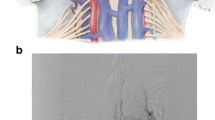Abstract
Purpose
Spinal vascular anomalies with arteriovenous blood shunting include spinal arteriovenous malformations (SAVMs) and spinal arteriovenous fistulas (SAVFs), which are distinguished by the presence or absence of an interposed nidus. SAVFs can be further characterized based on their location (perimedullary, dural, or extradural) and flow pattern (high-flow versus low-flow shunts). The spontaneous resolution of a spinal vascular malformation, i.e., the complete disappearance—in the absence of therapeutic measures—of a lesion previously identified by angiography, seems to represent an exceptional phenomenon.
Methods
This study retrospectively analyzed seven patients with spontaneously resolving spinal vascular malformations observed by the senior author between January 2008 and April 2017.
Results
A total of 143 spinal vascular malformations were angiographically evaluated during the considered time period, including nine spontaneously resolving SAVFs in six patients, seven spinal epidural fistulas, and two spinal dural arteriovenous fistula.
Conclusion
The “spontaneous” resolution of spinal vascular malformations appears to selectively involve SAVFs. While vessel wall alterations previously documented on the venous side of SAVFs may play an important role in the regression of these lesions, angiography seems to represent a significant contributing factor, probably through the prothrombotic properties of nonionic contrast agents.








Similar content being viewed by others
References
Flores BC, Klinger DR, White JA, Batjer HH (2016) Spinal vascular malformations: treatment strategies and outcome. Neurosurg Rev. doi:10.1007/s10143-016-0713-z
Riche MC, Melki JP, Merland JJ (1983) Embolization of spinal cord vascular malformations via the anterior spinal artery. AJNR Am J Neuroradiol 4(3):378–381
Aminoff MJ, Barnard RO, Logue V (1974) The pathophysiology of spinal vascular malformations. J Neurol Sci 23(2):255–263
Majeed N, Gailloud P (2016) Spontaneous resolution of a high-flow congenital spinal epidural arteriovenous fistula in a pediatric patient. J Pediatric Neuroradiol 04(02):029–031. doi:10.1055/s-0036-1579684
Torok C, Laufer I, Gailloud P (2013) Spontaneous resolution of a thoracic spinal epidural arteriovenous fistula caused by stabbing injury. Spine (Phila Pa 1976) 38(11):E683–E686. doi:10.1097/BRS.0b013e31828cf993
Riche MC, Reizine D, Melki JP, Merland JJ (1985) Classification of spinal cord vascular malformations. Radiat Med 3(1):17–24
Riche MC, Scialfa G, Gueguen B, Merland JJ (1983) Giant extramedullary arteriovenous fistula supplied by the anterior spinal artery: treatment by detachable balloons. AJNR Am J Neuroradiol 4(3):391–394
Benhaiem N, Poirier J, Hurth M (1983) Arteriovenous fistulae of the meninges draining into the spinal veins. A histological study of 28 cases. Acta Neuropathol 62(1–2):103–111
McCutcheon IE, Doppman JL, Oldfield EH (1996) Microvascular anatomy of dural arteriovenous abnormalities of the spine: a microangiographic study. J Neurosurg 84(2):215–220. doi:10.3171/jns.1996.84.2.0215
Rosenblum B, Oldfield EH, Doppman JL, Di Chiro G (1987) Spinal arteriovenous malformations: a comparison of dural arteriovenous fistulas and intradural AVM's in 81 patients. J Neurosurg 67(6):795–802. doi:10.3171/jns.1987.67.6.0795
Tender GC, Vortmeyer AO, Oldfield EH (2005) Spinal intradural arteriovenous fistulas acquired in late adulthood: absent spinal venous drainage in pathogenesis and pathophysiology. Report of two cases. J Neurosurg Spine 3(6):488–494. doi:10.3171/spi.2005.3.6.0488
Kinoshita M, Asai A, Komeda S, Yoshimura K, Takeda J, Uesaka T, Yamanouchi Y, Kanzaki H, Kawamoto K (2009) Spontaneous regression of a spinal extradural arteriovenous fistula after delivery by cesarean section. Neurol Med Chir (Tokyo) 49(7):313–315
Wirth FPJ, Post KD, Di Chiro G, Doppman JL, Ommaya AK (1970) Foix-Alajouanine disease. Spontaneous thrombosis of a spinal cord arteriovenous malformation: a case report. Neurology 20(11):1114–1118. doi:10.1212/WNL.20.11.1114
Chun JY, Gulati M, Halbach V, Lawton MT (2004) Thrombosis of a spinal arteriovenous malformation after hemorrhage: case report. Surg Neurol 61(1):92–94
Renowden SA, Molyneux AJ (1993) Case report: spontaneous thrombosis of a spinal dural AVM (Foix-Alajouanine syndrome)—magnetic resonance appearance. Clin Radiol 47(2):134–136
Aydin K (2004) Angiography-induced closure of perimedullary spinal arteriovenous fistula. Br J Radiol 77(923):969–973. doi:10.1259/bjr/30760081
Gupta V, Rizvi T, Garg A, Gaikwad SB, Mishra NK (2005) Postangiographic thrombosis of a spinal arteriovenous malformation: case report. J Neurosurg Spine 2(4):486–490. doi:10.3171/spi.2005.2.4.0486
Panciani PP, Fontanella M, Crobeddu E, Schatlo B, Bergui M, Ducati A (2010) Spontaneous occlusion of a spinal arteriovenous malformation: is treatment always necessary. J Neurosurg Spine 12(4):397–401. doi:10.3171/2009.10.SPINE09421
Meder JF, Devaux B, Merland JJ, Fredy D (1995) Spontaneous disappearance of a spinal dural arteriovenous fistula. AJNR Am J Neuroradiol 16(10):2058–2062
Schwartz ED, Hurst RW, Sinson G, Bagley LJ (2002) Complete regression of intracranial arteriovenous malformations. Surg Neurol 58(2):139–147. discussion 147
Marconi F, Parenti G, Puglioli M (1993) Spontaneous regression of intracranial arteriovenous malformation. Surg Neurol 39(5):385–391
Takai K, Usui M (2012) Spontaneous thrombosis of a spinal conus perimedullary arteriovenous fistula. Case report. Neurol Med Chir (Tokyo) 52(2):103–106
Stampfel G (1984) Spontaneous closure of traumatic carotid-cavernous sinus fistulae—an effect of angiography? Rofo 141(2):176–179. doi:10.1055/s-2008-1053111
Hay KL, Bull BS (1996) Factors influencing the activation of platelets by nonionic contrast medium. J Vasc Interv Radiol 7(3):401–407
Bellemain-Appaix A, Beygui F, Lesty C, Gupta S, Silvain J, Le Feuvre C, Cayla G, Allali Y, Montalescot G, Collet JP (2012) Impact of anticoagulation on ionic and nonionic contrast media effect on thrombogenesis and fibrinolysis: the PEPCIT study. Catheter Cardiovasc Interv 79(5):823–833. doi:10.1002/ccd.23080
Abeyama K, Oh S, Kawano K, Nakajima T, Soejima Y, Nakano K, Maruyama I (1995) Nonionic contrast agents produce thrombotic effect by inducing adhesion of leukocytes on human endothelium. Biochem Biophys Res Commun 212(3):776–783. doi:10.1006/bbrc.1995.2036
Author information
Authors and Affiliations
Corresponding author
Ethics declarations
Funding
No funding was received for this study.
Conflict of interest
PG consults for Codman Neurovascular and has received research grants from Siemens Medical.
Ethical approval
All procedures performed in the studies involving human participants were in accordance with the ethical standards of the institutional and/or national research committee and with the 1964 Helsinki Declaration and its later amendments or comparable ethical standards. For this type of study formal consent is not required.
Informed consent
Informed consent was obtained from all individual participants included in the study.
Rights and permissions
About this article
Cite this article
Kang, J., Gregg, L. & Gailloud, P. Spontaneous resolution of low-flow spinal arteriovenous fistulas. Neuroradiology 59, 1003–1012 (2017). https://doi.org/10.1007/s00234-017-1888-x
Received:
Accepted:
Published:
Issue Date:
DOI: https://doi.org/10.1007/s00234-017-1888-x




